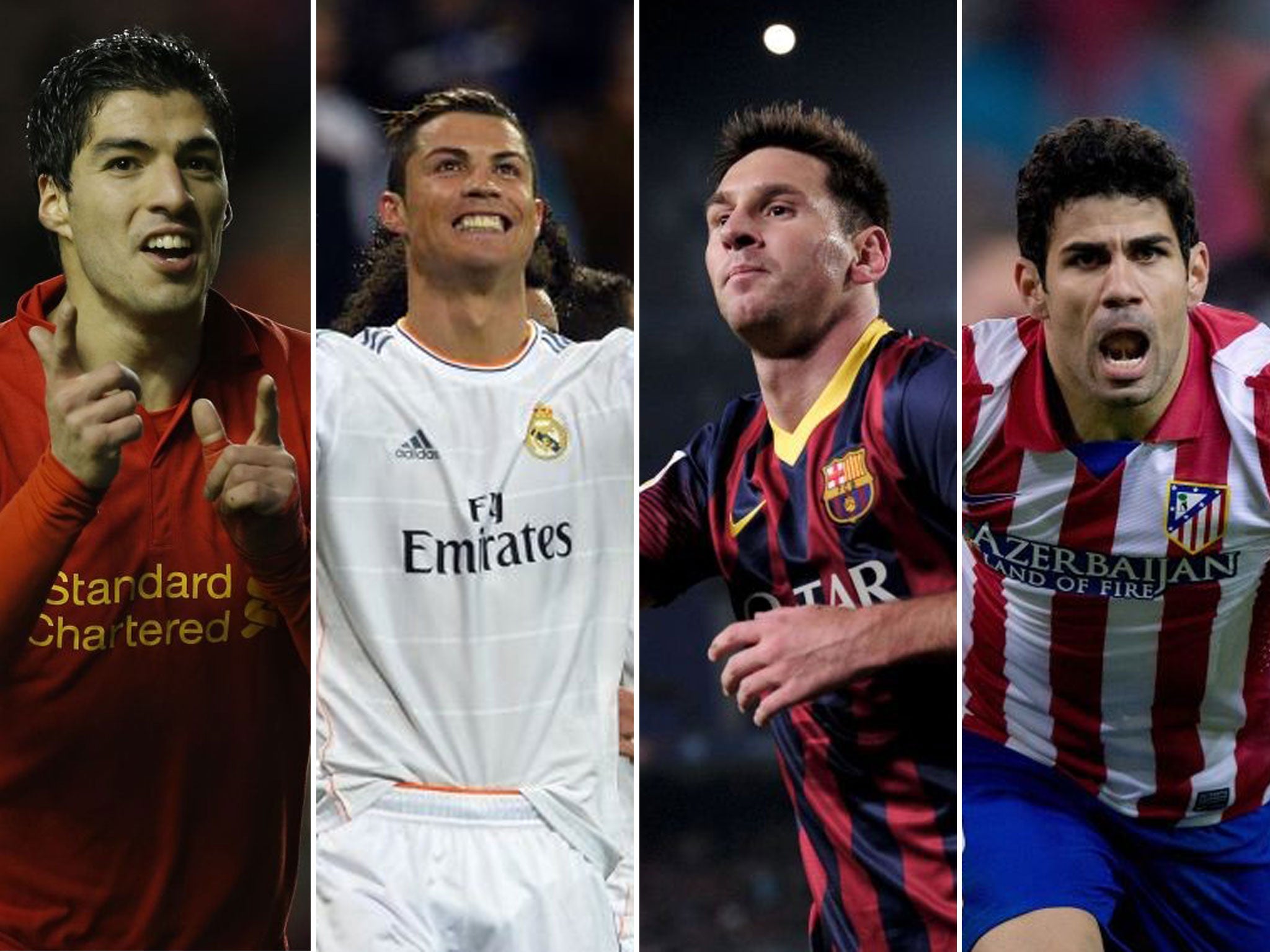Goals galore: Likes of Luis Suarez, Cristiano Ronaldo and Diego Costa hitting the net at a rate not seen since Greaves, Puskas and Di Stefano

Mark Hughes may be hoping to upset expectations against Liverpool today, but there is one inevitability he is resigned to.
"With a player like Luis Suarez," the Stoke City manager said, "you have to accept that, with the talent he has, he will have an opportunity at some point in the game to test the keeper."
You also have to accept that, with the supreme form he is in, the Uruguayan will likely take that opportunity. Should Suarez hit his 21st League strike of the campaign this evening, it would continue the trend of the season – but not just his own. Maintaining a ridiculous strike rate of 1.33 goals a game in the League at present, the 26-year-old is one of a series of super-forwards hitting the net at a rate of about once a game in Europe's top competitions.
Suarez, Cristiano Ronaldo and Diego Costa are well above that level; Sergio Aguero, Zlatan Ibrahimovic and Leo Messi are just under it.
This rate of scoring represents a significant break with history. The kind of records that Eusebio used to monopolise in the lower quality of the Portuguese League are now much more common. As the stats here indicate, the game is currently seeing an unusually high number of strikers scoring relentlessly in the elite divisions.
That may not seem so relevant when you remove Ronaldo and Messi from the list, but a deeper look reveals the effect of the duo's dominance. It is not just the number of goals, but the number of forwards who are scoring them.
There have never been so many hitting the net quite so freely since the 1960-61 campaign. Then, just before a common move to four at the back made football more minimalist, Jimmy Greaves, Ferenc Puskas, Ray Crawford, Omar Sivori and Alfredo Di Stefano were decimating defences.
Now it as if Ronaldo and Messi have rewritten the rules again. For most of the last few decades, a scoring rate of one goal every two games seemed thoroughly respectable for a player. At present, it seems somewhat paltry.
Mario Kempes famously won a Golden Boot with Argentina in the more austere era of the 1978 World Cup and points to a rare batch of "great forwards". Exceptional talent alone, however, does not fully explain why the likes of Suarez are scoring so much more than previous greats such as Kempes and the Brazilian Ronaldo.
Ian Rush, who preceded Suarez in striking close to such levels for Liverpool even in the 1980s, thinks "it's easier now to score goals".
"Obviously the game has changed," Rush says. "It's a lot quicker. You're not going to get kicked from behind anymore. You feel more comfortable when you have your back to goal."
There's also the increased openness of the game. Just as the move to four at the back in the mid-1960s closed up football and drastically reduced scoring rates, the influence of Pep Guardiola's Barcelona ripped it open again in the last few years. Everton manager Roberto Martinez has argued that a number of teams have been conditioned into adapting individual elements of the ultra-attacking Catalan approach, not least building moves from the back. This is something Rush agrees with "100 per cent", and believes it plays into the feet of forwards.
"I think most defenders now, they're there to play football, not try to be like defenders," Rush explains. "In the 70s and 80s, defenders were proper defenders and used to kick you and everything. The likes of John Terry and Jamie Carragher seem to be a dying breed. They're brought up to play football and, one thing is for certain, a striker will always think quicker than a defender. That's one of the differences as well.
"There's not many big, solid defenders now and sometimes you need them. When you put defenders who like to play at the back against world-class strikers, the world-class strikers will always come out on top because they think quicker."
It is not just the circumstances that are loaded in favour of the forwards. It is also the talent.
"I believe now you have better forwards and weaker defenders," Kempes says. While the game is currently dominated by a host of historically good attackers, it's actually difficult to pick out too many defenders at that level, or even decide the best centre-half in the world. Truly cast-iron defenders like Franco Baresi, Fabio Cannavaro or even Nemanja Vidic do not seem to have many modern successors.
Worse, those who do exist tend already to be playing with the finest forwards. That is the other aspect. While Rush and Kempes played in egalitarian eras where ability was more spread out, modern economics ensure there has never been such a concentration of talent at so many big clubs.
"For each competition in Europe," Kempes argues, "there are three or four good teams and the rest are very weak. The top forwards play in the good teams and this plays to their advantage."
The likes of Suarez, meanwhile, are more than ready to take advantage – repeatedly and relentlessly.
Stoke City v Liverpool is on Sky Sports 1, kick-off 4.10pm
Subscribe to Independent Premium to bookmark this article
Want to bookmark your favourite articles and stories to read or reference later? Start your Independent Premium subscription today.

Join our commenting forum
Join thought-provoking conversations, follow other Independent readers and see their replies